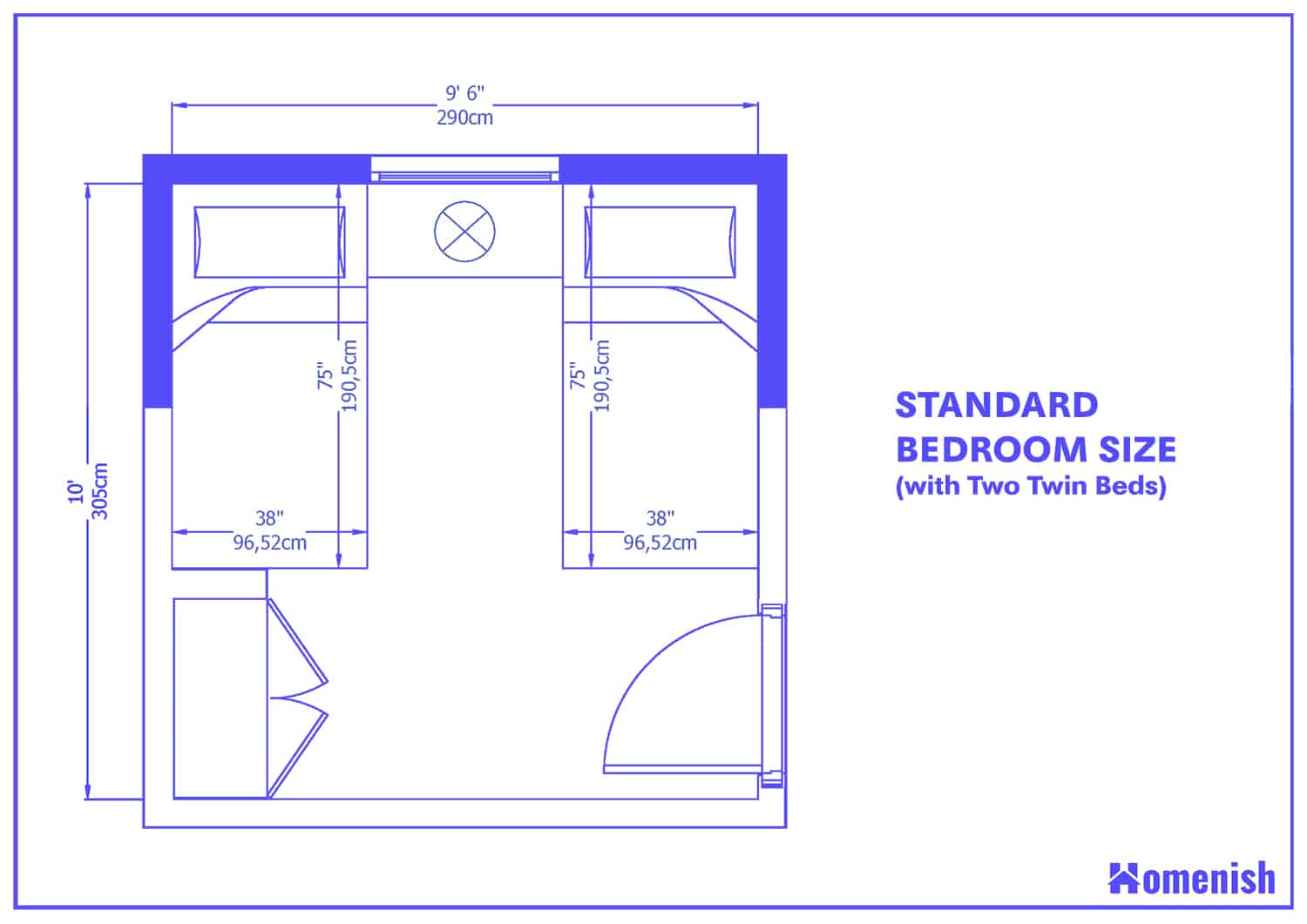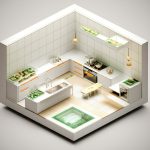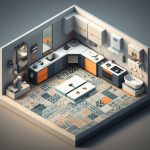Ready to transform your bedroom into a personalized sanctuary? This comprehensive guide delves into standard bedroom dimensions, offering practical tips and design considerations for creating a space that perfectly balances comfort, functionality, and style. Whether you’re buying, building, or simply rearranging, understanding bedroom dimensions is crucial for maximizing space and achieving your desired aesthetic.
Understanding Bedroom Dimensions
When envisioning a home, bedrooms often take center stage. Given the significant portion of our lives spent within these walls, understanding average bedroom sizes is essential for effective space planning and creating the right atmosphere. Whether you’re furnishing a new room or reimagining your current space, knowing typical dimensions helps visualize furniture placement and assess usable space.
The concept of an “average” bedroom size, however, isn’t absolute. Several factors influence typical dimensions, including the overall home size, the bedroom’s designated purpose (master, guest, child’s room), and even regional building customs. In the US, the commonly cited average bedroom size is approximately 132 square feet (roughly 11 feet by 12 feet). This typically accommodates a queen-sized bed, nightstands, and a dresser, with reasonable moving space. However, this figure varies, with some sources suggesting an average closer to 202 square feet for standard bedrooms in houses. This discrepancy likely stems from differing methodologies or the inclusion of larger master bedrooms in some calculations.
Let’s explore the typical dimensions of various bedroom types:
Master Bedrooms: Designing Your Personal Retreat
Master bedrooms often claim the title of largest bedroom, especially in newer constructions. Designed as private retreats, these rooms prioritize comfort and relaxation. Typical dimensions range from 14 feet by 18-20 feet, sometimes even 15 feet by 18 feet. This expanded square footage allows for king-size beds, larger dressers, sitting areas, and even vanities. Luxury homes or custom builds may feature even more expansive master suites, sometimes exceeding 370 square feet.
Standard Bedrooms: Versatile Living Spaces
Standard bedrooms represent the quintessential “regular” bedroom. In a typical 2,500 square foot home, these rooms average around 202 square feet, but can vary significantly, ranging from approximately 109 to 299 square feet. This range often reflects differences between houses and apartments, with apartment bedrooms tending to be smaller due to space constraints. These rooms generally include a window and closet, offering flexibility for use as guest rooms, home offices, or hobby spaces, in addition to their primary function.
Children’s Bedrooms: Balancing Play and Growth
Functionality often outweighs sheer size in children’s bedrooms. These rooms typically range from 50 to 150 square feet—often half or a third the size of a standard bedroom. The focus shifts to accommodating essential furniture like a bed, dresser, and potentially a desk, while preserving ample space for play and growth.
Beyond Averages: Prioritizing Your Unique Needs
While averages provide a helpful starting point, the “perfect” bedroom size hinges on individual needs and lifestyle. Consider who will use the room, the necessary furniture, and intended activities. Will the bedroom incorporate a home office? Does a child’s room require a designated play area? Do you have an awkward space under window that needs addressing? These factors significantly influence the ideal bedroom dimensions.
Understanding average sizes is valuable, but prioritizing specific circumstances is paramount. By considering your unique needs, you can cultivate a space that not only functions efficiently but also resonates with your personal style and promotes a sense of well-being. Adding a touch of comfort and luxury with an artificial fur blanket can further enhance the sense of sanctuary in your bedroom.
Is a 12×12 Bedroom Right for You? Size, Layout, and Design Considerations
A 12×12 bedroom, providing 144 square feet, is a common dimension, but its suitability depends on individual needs. This section explores the advantages and disadvantages of a 12×12 space to help you determine if it aligns with your lifestyle.
A 12×12 room offers a sense of coziness and intimacy, appealing to those who prefer a manageable space. It comfortably accommodates essential furniture like a bed, dresser, and nightstands. The smaller footprint may also contribute to lower heating and cooling costs.
However, limitations exist. With excessive furniture or belongings, a 12×12 bedroom can feel cramped. Storage may also present challenges, often lacking walk-in closets or en-suite bathrooms. This necessitates strategic organization and creative storage solutions. Accommodating additional functions, such as a home office or hobby area, within a 12×12 room may also prove difficult.
Consider your intended use for the space. A minimalist sanctuary thrives in a 12×12 room, while a multifunctional space may require more square footage. While some find 144 square feet perfectly adequate, others may feel confined. Personal preference plays a significant role.
Here’s a summary of the pros and cons:
| Pros | Cons |
|---|---|
| Cozy and intimate atmosphere | Can feel cramped with excessive furniture |
| Fits essential bedroom furniture | Limited storage space |
| Potentially lower utility costs | Not ideal for multiple uses |
For single occupants embracing minimalism, a 12×12 bedroom often suffices, comfortably fitting a queen-size bed with ample moving space. However, shared rooms or those housing hobbies and equipment likely benefit from larger dimensions. A king-size bed, for example, consumes significant space within a 12×12 room, potentially limiting other furnishings.
Strategic furniture placement is essential in smaller rooms. Maximize space and flow by considering vertical storage solutions like shelves and wall-mounted units.
Ultimately, the ideal bedroom size is subjective. While some recommend minimum square footage, the true measure lies in the room’s comfort and functionality for the individual. A 12×12 bedroom can be perfectly acceptable, especially with thoughtful planning and organization. However, if doubts linger, opting for more space is often advisable. Creating a relaxing and rejuvenating environment is paramount, given the considerable time spent in the bedroom.
Is 100 Square Feet Enough? A Realistic Look at 10×10 Bedrooms
A 10×10 bedroom, totaling 100 square feet, is smaller than the average but can be a functional and comfortable space with thoughtful planning and design. Rather than perceiving it as cramped, envision it as a cozy retreat.
Twin or full-size beds fit comfortably within a 10×10 room, potentially leaving space for a small desk or armchair. A queen-size bed might fit, but could feel tight, particularly for those who prefer ample moving space. King-size beds, however, likely dominate the room, leaving little room for other furniture. Therefore, a 10×10 room may not suit those preferring king-size beds.
Here are strategies for maximizing a 10×10 bedroom:
-
Choose Furniture Wisely: Prioritize multifunctional furniture. Storage ottomans, beds with built-in drawers, and slim desks maximize space and functionality. Captain’s beds are also excellent storage solutions.
-
Vertical Storage is Your Friend: Utilize vertical space with tall bookshelves, wall-mounted shelves, and hanging organizers. This optimizes storage without sacrificing valuable floor space.
-
Layout Optimization is Key: Strategic furniture placement significantly impacts perceived spaciousness. Experiment with arrangements to maximize flow. Positioning the bed against a wall frees up floor space. Nightstands with drawers offer bedside storage without consuming excessive space. Avoid obstructing windows or doorways to maintain a sense of openness.
-
Light and Bright: Light, neutral wall colors create the illusion of spaciousness. Mirrors strategically placed can amplify light and create a more open feel. Prioritize both natural and artificial lighting. Sheer curtains allow natural light while preserving privacy.
-
Declutter Regularly: Clutter quickly overwhelms small spaces. Regular decluttering and organization are crucial. Utilize storage bins, drawer organizers, and under-bed storage to maintain tidiness.
Pros and Cons of a 10×10 Bedroom:
| Pros | Cons |
|---|---|
| Cozy and intimate feel | Limited space for furniture |
| Easier to heat and cool | Can feel cramped with excessive clutter |
| Can be more affordable | Not ideal for two people |
| Encourages minimalist living | Challenging to fit a king-size bed |
Expert opinions on the suitability of a 10×10 bedroom vary. Some suggest it’s ideal for single occupants or children, while others deem it too small. Ultimately, its adequacy depends on individual needs and lifestyle. Minimalists valuing coziness may find it perfectly suitable, while those with numerous belongings or a preference for spaciousness might feel restricted.
There’s no universal answer. The key takeaway is that with careful planning and creativity, even smaller rooms can transform into functional and stylish havens. It’s not about the square footage, but how you utilize it.
Decoding Normal Bedroom Dimensions: A Comprehensive Guide to Standard Sizes & Layouts
Considering a move, renovation, or simply dreaming of the ideal sleep sanctuary? Bedroom size significantly impacts comfort, furniture capacity, and even sleep quality. This guide explores “normal” bedroom dimensions, acknowledging the subjectivity of the term and the various factors influencing ideal sizes.
A typical US bedroom averages around 132 square feet (roughly 11 by 12 feet). This comfortably accommodates a queen-size bed, dresser(s), and nightstand(s). This size is prevalent, particularly in older homes or apartments. However, this represents an average, and bedroom dimensions can fluctuate significantly based on the house, its age, and location. Some sources even suggest an average closer to 202 square feet for standard bedrooms in houses, highlighting the variability in data.
Master bedrooms, the ultimate sleep havens, tend to be more spacious. Newer homes often feature master bedrooms exceeding 224 square feet, sometimes significantly larger. These rooms accommodate king-size beds, walk-in closets, and even sitting areas, enhancing the luxurious and relaxing atmosphere.
Standard bedrooms are typically smaller than the average, around 120 square feet. While still fitting essential furniture, they may require more creative arrangements. This size is frequent in older homes or apartments where space is limited.
Minimum bedroom sizes are subject to legal regulations, which vary by state. Some areas permit bedrooms as small as 70 square feet. While technically legal, such spaces can feel cramped, accommodating little beyond a twin bed and small dresser. Long-term comfort might be compromised in such limited quarters.
Children’s rooms present a unique scenario. With smaller bed sizes (twin or single), their rooms can also be smaller. However, these spaces often demand clever design for storage and play areas, requiring parents to maximize functionality within limited square footage.
Ideally, guest bedrooms offer around 450 square feet for optimal visitor comfort. Realistically, many guest rooms are smaller, often mirroring standard bedroom dimensions. The available space and frequency of guest visits influence the appropriate size.
Here’s a table summarizing typical bedroom sizes:
| Bedroom Type | Approximate Size (sq ft) | Notes |
|---|---|---|
| Average | 132 | Fits a queen bed and basic furniture comfortably. |
| Master | 168-224+ | Often larger in newer homes; may include additional features like sitting areas. |
| Standard | 120 | Fits essential furniture but may require creative arrangement. |
| Minimum (varies) | 70+ | May feel cramped; suitable for a single/twin bed and limited furniture. |
| Guest | 450 (ideal), smaller often sufficient | Comfort level for visitors varies; size often depends on available space. |
| Child’s | Smaller than adult rooms | Design often prioritizes play and storage. |
These figures serve as guidelines. There’s no one-size-fits-all answer for bedroom dimensions. The “perfect” size depends on personal needs, lifestyle, and the home’s overall layout. Some prefer cozy intimacy, while others value spaciousness. Consider your specific wants and needs when designing your dream bedroom to create a truly personalized haven. Ongoing research into living spaces and comfort continually evolves our understanding of “normal,” so today’s standards may shift in the future.
- Backsplash Colors for White Cabinets: Find Your Perfect Match - November 19, 2025
- Backsplash Ideas for White Cabinets: Find Your Perfect Style - November 18, 2025
- White Tile Backsplash Kitchen: A Classic and Clean Design - November 17, 2025










